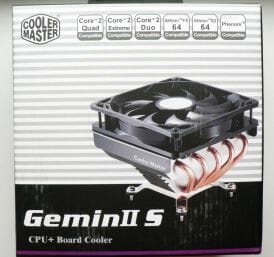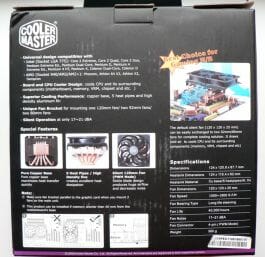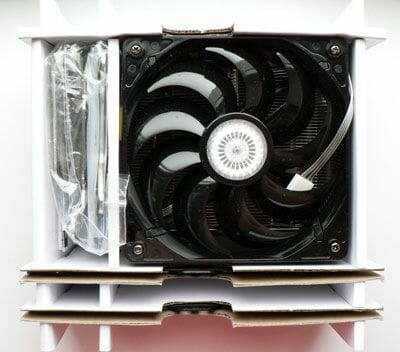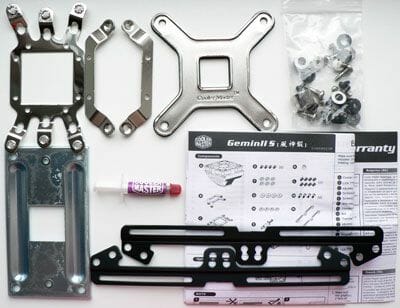Cooler Master GeminII S: Small Doesn’t Mean Inefficient

We are going to talk about a compact version of a giant GeminII super-cooler from Cooler Master. Our review will reveal how surprisingly efficient this little guy turns out!
Overclockers remember early spring of 2007 when Cooler Master released their GeminII CPU cooler. The size of this cooling solution amazed even experienced overclocking fans. This cooler used a copper base and 6 copper heatpipes holding a heatsink big enough for two 120-mm fans. However, this highly efficient cooler couldn’t fit on a number of mainboards, because of its dramatically large size. Moreover, the very first versions of this cooler didn’t use a backplate for LGA775 platforms, which also caused a lot of users’ complaints.
Cooler Master wanted to keep the efficient cooling of the around-the-socket area and CPU provided by GeminII in a more compatible solution. That is why they released a new cooler called GeminII S, where “S” must stand for the first letter of the word “Small”. So, we dare conclude that the new modified version of the GeminII cooler is of much smaller size than its elder brother. Besides, GeminII S has one heatpipe less and is bundled no only with a fan (there were no fans bundled with the GeminII cooler), but also with a backplate for LGA775 mainboards.
Our today’s article is going to dwell on this interesting cooler, its efficiency and acoustic characteristics.
Package and Accessories
Cooler Master GeminII S CPU cooler is shipped in a compact box made of thick cardboard. There is a large cooler photo on the front of the package together with a number of small pictograms indicating the CPUs it is compatible with:


The reverse side of the box lists cooler key features, installation options and has a special table with the cooling system technical specifications.
The cooler and accessories are sitting in special cardboard sections inside the box, which protects the cooler and accessories against any possible physical damage during transportation:

Cooler Master GeminII S comes bundled with everything necessary to install this cooler on any of the supported platforms and to expand its functionality:

Besides the cooler itself, you can also find the following components inside the box (from left to right and from top to bottom):
- Steel retention plate for AMD K8 mainboards;
- Two steel retention brackets for LGA775 mainboards;
- Backplate for LGA775 mainboards;
- A set of screws, plastic washers, rubber ring-pads, screw-nuts and a special wrench for them;
- Cooler Master thermal compound;
- Two metal railings for installing two fans on top of the cooler heatsink;
- Assembly and installation manual in multiple languages.
Cooler Master GeminII S is a not a brand new cooling system (it was announced about 7 months ago) that is why it is already available for $39 dollars retail price. According to the info on the box, it is made in Taiwan.
Design and Functionality
There is nothing extraordinary about the cooler design, especially against the background of recently released cooling solutions.
Cooler Master GeminII S is of modest dimensions. It measures 124 x 120.8 x 75mm, which means it is only 7.5cm tall (!). That is why it will easily fit into compact system cases. It weighs 560g, which is also not much at all.
In fact, the cooler consists of four major components: copper base, copper heatpipes, two types of aluminum plates and a fan with an aluminum retention frame. Five copper heatpipes 6mm in diameter come out of the copper base plate and pierce the top of the aluminum heatsink.
The heatpipes are lined up inside the heatsink. They lie in specially cut grooves in the cooler base. Heatpipes are not the only ones soldered to the cooler base. The central heatsink array is also soldered to the base. We saw the same approach in Noctua NH-C12P cooler. Here are a few more pictures of the cooler heatsink without the fan.
The heatsink plates are spaced out at 2mm and are about 0.20~0.25mm thick. The photograph below will give you a better idea of the Cooler Master GeminII S actual size.
Here I would like to say that although Cooler Master GeminII S is practically half the size of the recently tested TITAN CoolIdol, it doesn’t yield to it in efficiency in all tests. It is actually a very illustrative example, of how good coolers should actually be made.
The copper base is covered with protective plastic film. Its finish quality is remarkable. The base surface is extremely even and the thermal compound imprint on the glass surface as well as on the processor heat-spreader is practically ideal.
Cooler Master GeminII S is equipped with a 120 x 120 x 25mm fan with 9 glossy crescent-shaped blades. The fan is fastened to the metal frame with four screws. This frame is attached to the side of the heatsink.
The fan is connected to the four-pin mainboard connector and its rotation speed is automatically controlled using PWM method. The specifications claim that it varies from ~1000RPM to ~2000RPM with 69.69CFM maximum airflow and 17-21dBA noise level. The latter may be claimed lower than it actually is. We will have to check it out during our test session.
The fan uses a slide bearing with claimed 40,000 hours MTBF (~4.5 years of non-stop operation). It maximum power consumption equals ~4.2W.
The monitoring utilities reported the fan rotation speed varying from ~800RPM to ~1800RPM during our test session. Here I have to remind you that the predecessor of our today’s hero, Cooler Master GeminII cooler, was shipped without any fans at all.
Installation Tips
Cooler Master solutions are still installed onto mainboards the same way as before. Before installing the cooler you have to attach corresponding retention plate(s) to the cooler base using the included screws.
Depending on the socket type you insert (rotating counterclockwise) two or four spindles into the loops of the retention plates and stick special rubber rings to them that will protect the mainboard PCB from damage when the cooler is installed.
After that you remove the plastic film from the cooler base and apply thermal compound to it. Then you place the mainboard on top of the cooler standing upside down, place the corresponding backplate where it should be and tighten the whole thing with screw nuts using the enclosed wrench. Considering how small the cooler actually is, the only “inconvenience” here is removing the board from the system case before Cooler Master GeminII S installation. However, the cooler will be fastened very securely, and the PCB will not bend in any way. As you remember, the first GeminII cooler was initially shipped without any backplates.
In conclusion I would only like to add that GeminII S is also bundled with two metal railings that allow installing two 120-mm fans on top of its heatsink. However, only one of them will be cooling the heatsink. The other one will cool either memory modules or mainboard chipset heatsink. It is a very interesting solution that gives the users a lot of flexibility in determining the prioroties.
If I missed something about the cooelr installation, you can always check out the step-by-step installation guide for Cooler Master GeminII S available on the official web-site (PDF file, 831KB).
Testbed and Methods
Cooler Master GeminII S and its competitor were tested in two modes: in an open testbed when the mainboard sits horizontally on the desk and the cooler is installed vertically, and in a closed testbed with the mainboard in vertical position. Cooler Master GeminII S was installed with the heatpipe ends facing upwards (towards the PSU).
Our testbed was identical for all coolers and featured the following configuration:
- Mainboard: ASUSTek P5K Deluxe/WiFi-AP (Intel P35), LGA 775, BIOS 0812
- Processor: Intel Core 2 Extreme QX9650 (3.0GHz, 1.25V, 2x6MB L2 cache, 4x333MHz FSB, Yorkfield, C0)
- Thermal interface: Arctic Silver 5 (for all coolers)
- Graphics card: HIS Radeon HD 4850 GDDR3 512MB / 256bit, 725/2275MHz
- Graphics card cooler: Arctic Cooling Accelero S1 + Turbo Module
- Memory:
- 2 x 1024MB DDR2 Corsair Dominator TWIN2X2048-9136C5D (1142MHz / 5-5-5-18 / 2.1V);
- 2 x 1024MB DDR2 CSXO-XAC-1200-2GB-KIT DIABLO (1200MHz / 5-5-5-16 / 2.4V).
- Disk subsystem: Samsung HD501LJ (SATA-II, 500GB storage capacity, 7200rpm, 16MB cache, NCQ)
- HDD silencer and cooler: Scythe Quiet Drive 3.5”
- Optical drive: Samsung SH-S183L SATA-II DVD RAM & DVD±R/RW & CD±RW
- System case: System case: ASUS ASCOT 6AR2-B Black&Silver (ATX) with 120mm ~960RPM Scythe Slip Stream fans for air intake and exhaust (the fans are installed on silicon spindles), and the same 120mm ~800RPM fan on the side panel
- Control and monitoring panel: Zalman ZM-MFC2
- Power supply: Enermax Galaxy EGA1000EWL 1000W (a default 135mm fan for intake; and 80mm fan for air exhaust)
All tests were performed under Windows XP Professional Edition SP3. SpeedFan 4.34 was used to monitor the temperature of the CPU and mainboard, reading it directly from the CPU core sensor and to monitor the rotation speed of the cooler fans.
The mainboard’s automatic fan speed management feature was disabled for the time of the tests in the mainboard BIOS. The CPU thermal throttling was controlled with the RightMark CPU Clock Utility version 2.35.0.
The CPU was heated up with OCCT (OverClock Checking Tool) version 2.0.0a in a 23-minute test with maximum CPU utilization, during which the system remained idle in the first 1 and last 4 minutes of the test.
I performed at least two cycles of tests and waited for approximately 20 minutes for the temperature inside the system case to stabilize during each test cycle. The stabilization period in an open testbed took about half the time. Despite the stabilization period, the result of the second test cycle was usually 0.5-1°C higher. The maximum temperature of the hottest CPU core of the four in the two test cycles was considered the final result (if the difference was no bigger than 1°C – otherwise the test was performed at least once again).
The ambient temperature was checked next to the system case with an electronic thermometer that allows monitoring the temperature changes over the past 6 hours. During our test session room temperatures varied between 24.5-25.0°C. It is used as a staring point on the temperature diagrams. Note that the fan rotation speeds as shown in the diagrams are the average readings reported by SpeedFan, and not the official claimed fan specifications.
We will be comparing the cooling efficiency of the Cooler Master GeminII S against that of Thermalright SI-128 SE air cooler (~$55 + $10) equipped with the fan from Cooler Master GeminII S.
In other words, we will be comparing different heatsinks, and not different coolers. It is important to keep in mind that Thermalright SI-128 SE is chipped without a fan and its recommended retail price is about 40% higher than that of Cooler Master GeminII S ($55 vs. $39). Nevertheless, this is the comparison we will make, because these coolers are of the same topology and besides, we consider SI-128 SE the best solution among contemporary air coolers, as you know.
Cooling Efficiency Tests
Inside a closed system case using the “weakest” cooling system of the two we managed to overclock our 45nm quad-core processor to 3.9GHz (+30%). The nominal processor Vcore was increased to 1.55V in the mainboard BIOS (+24%).
According to the monitoring utilities, the CPU core voltage was a little lower than was set in the mainboard BIOS, namely it was around 1.51~1.52V.
Conclusion
Although Cooler Master GeminII S showed lower cooling efficiency than our reference air cooler, it deserves our best response. First of all, although this cooler doesn’t boast currently popular “gigantic” size, it cools perfectly well a seriously overclocked quad-core processor. I assume, it would be illogical to expect record-breaking performance from a 75mm cooler. Moreover, do not forget that Cooler Master GeminII S is priced at a very affordable level of only $39.
Among other advantages I definitely have to point out that the cooler is universal and supports PWM control of the fan rotation speed, so it becomes noisy only during maximum CPU utilization (37.4dBA/1m). And when you do some everyday work or play games with major load on the graphics card, you can’t hear it at all even against a relatively quiet system case.
I would also like to mention again that you can add another fan to Cooler Master GeminII S and make it even more functional: it will also cool the memory modules or the mainboard chipset heatsink. As a result, you get a cooler with a very attractive price-to-performance combination. Cooler Master definitely did a very good job.